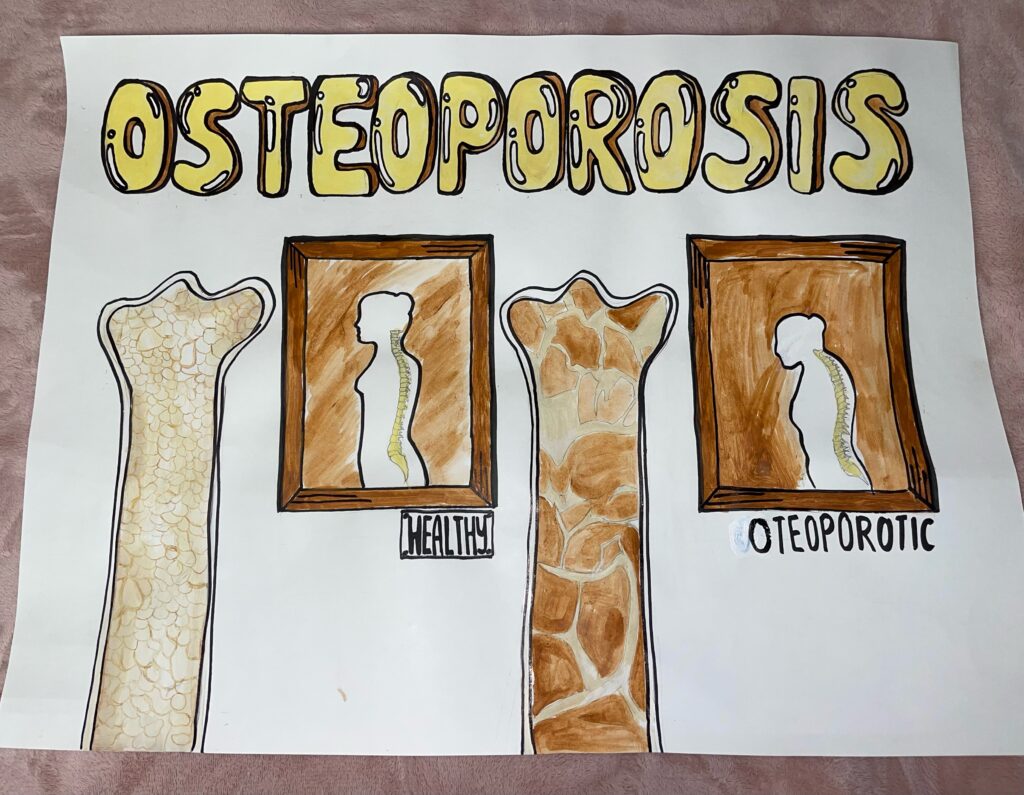I am covering the objective of how bone development is hormonally regulated in primary osteoporosis. The medium I have used is a painting comparing a healthy bone and a bone with osteoporosis. I will also be comparing a human body that has osteoporosis and one that does not.
Osteoporosis is a condition that occurs when there is more osteoclastic activity of bone resorption than the osteoblastic activity of bone formation. This imbalance results in the deterioration of bone mass and tissue as well as the disturbance of bone structure. The weakened bone structure leads to a higher risk of vertebral fractures. Vertebral fractures lead to many secondary complications that could be life-threatening.
In addition, a few complications someone with osteoporosis can face are intense bone fractures found in the hip or spine. Having an injury in the hip could result in a high risk of death. But having a fracture in the spine causes symptoms of back pain, shortening of height over time, and a hunched posture (Clinic, 2021).
There are two types of primary osteoporosis. There is Involutional Osteoporosis Type I & II. Type I is where there is a lack of estrogen that mostly affects the trabecular bone. Men have a relatively consistent production of testosterone throughout their life compared to the sudden drop in the production of estrogen after a woman experiences menopause. This causes postmenopausal women to be more affected than men. Women are more predisposed to osteoporosis because their hormonal decreases after menopause. Now, type II is the overload of bone mass caused by aging (Özışık, 2016).
Osteoporosis is commonly found in the spine, wrist, and hip of older people and post-menopausal women (Rachner et al., 2011). There are also other risk factors involved with osteoporosis. Lack of exercise, smoking, consumption of alcohol, demographics like women, Caucasians, Asians, and individuals with a family history are all at a higher risk of osteoporosis. Even lowered sex hormones increase the risk levels because of the brittle bones. Also, having an overload of thyroid hormones can create bone loss (Adler, 2014). Other risk factors could be listed under the umbrella branch of secondary osteoporosis. Most studies show that 20% to 30% of postmenopausal women and more than half of men have a secondary cause of osteoporosis. Secondary osteoporosis could be caused by lifestyle changes, diseases, and medications. Examples of osteoporosis secondary causes are low calcium intake eating disorders, diabetes mellitus, and growth hormone deficiency (Ganesan et al., 2022).
However, one treatment for osteoporosis is the intake of calcium and vitamin-D supplements. This helps with the prevention and treating osteoporosis. Two are taking bisphosphonates which help slow down bone resorption and increase bone growth (Salari Sharif et al., 2010). Lastly, lifting weights can increase bone density and help lower the risk of osteoporosis.
In conclusion, osteoporosis is a disease that weakens the bones and is mostly seen in post-menopausal women. With two types of Involutional Osteoporosis, type I and type II. Osteoporosis has many life-threatening and long-term effects. This is not a disease that can be fully cured but can be treated.
References
Adler, R. A. (2014, April 29). Osteoporosis in men: A Review. Bone research. Retrieved July 2,
2022, from https://www.ncbi.nlm.nih.gov/pmc/articles/PMC4472130/
Clinic, M. (2021, August 21). Osteoporosis. Mayo Clinic. Retrieved July 2, 2022, from https://www.mayoclinic.org/diseases-conditions/osteoporosis/symptoms-causes/syc-20351968#:~:text=A%20lifelong%20lack%20of%20calcium,in%20both%20men%20and%20women.
Ganesan, K., Jandu, J. S., & Roane, D. (2022, April 30). Home – books – NCBI. National Center for Biotechnology Information. Retrieved July 2, 2022, from https://www.ncbi.nlm.nih.gov/books
Salari Sharif, P., Abdollahi, M., & Larijani, B. (2010, July 30). Current, new and future treatments of osteoporosis – rheumatology international. SpringerLink. Retrieved July 2, 2022, from https://link.springer.com/article/10.1007/s00296-010-1586-z#Sec2


Abstract:
Osteoporosis is a condition that happens due to more osteoclastic activity of bone resorption than the osteoblastic activity of bone formation. This results in the bone deteriorating of the bone and tissue and ruins the bone structure. The problems that may happen with someone with osteoporosis are fractures found in the hip or spine. Someone with osteoporosis is more prone to injuries and more likely to lose balance. The types of osteoporosis are Type I and II. The differences between the two are that Type I are more lacking in estrogen affecting certain bones. This is more common for women than men. Men end up getting osteoporosis due to the lack of testosterone, and then a sudden drop of it, making their body produce estrogen. Women experience it after menopause since the estrogen levels drop. Type II is very different from Type I since Type II involves the overload of bone mass caused by aging.
Since Osteoporosis is commonly found in the wrist, spine, and hips, for elders and women after menopause, they have more of a risk. This may happen because of lack of exercise, smoking, alcohol consumption, bad lifestyle and many more. Women that are more at risk of osteoporosis are caucasians, Asians and those with a family history of osteoporosis. A treatment that can help with osteoporosis is intake of calcium and vitamin- D supplements. This will help with the bone, slow the process of deteriorating and help with restoration of the bone. Lastly, osteoporosis is a disease that weakens the bones and is mostly seen in women after menopause.